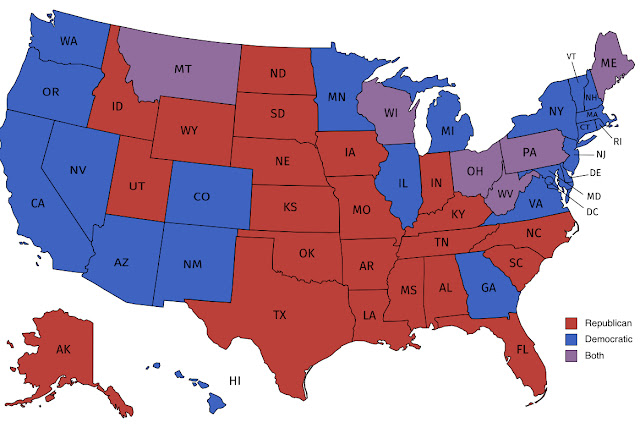The United States presidential election of 2020 was three months ago. But, one thing interesting about it, as it was as well in 2016, was a parallel for states’ voters choosing to color red or blue.
For the first time in history, in 2016 every state with a scheduled U.S. Senate election to go along with U.S. President carried for the same political party at both levels. (In Elections 2004, 2008, and 2012, same-party carriage—U.S. President vs. U.S. Senate—ran at about an 80-percent rate. In other words: If there were 33 or 34 states on the schedule, about 25 to 27 delivered same-party outcomes.)
Election 2020 was a near repeat. In Maine, the statewide and the 1st Congressional District (Portland and surrounding areas) carried Democratic for Joe Biden. The 2nd Congressional District (Bangor and surrounding areas), a 2016 Republican pickup for Donald Trump, was retained by the unseated president. But for U.S. Senate, then-vulnerable Republican incumbent Susan Collins beat back Democratic challenger Sara Gideon to win re-election. It was the only state—that is, based on statewide outcomes—which colored both red [U.S. Senate] and blue [U.S. President]. Then again, it was really the combined numbers in votes from Maine #01 vs. Maine #02 which decided on the statewide results in Maine. (Side note: Nebraska’s 2nd Congressional District, which includes Omaha, was a 2020 Democratic pickup for Joe Biden. The margins from the state’s 1st and especially 3rd congressional districts keep the state for U.S. President, and its two U.S. Senate seats, Republican.)
An even more interesting parallel—an alignment—came effective with the January 2021 runoff elections in Georgia: With exceptions of six states, all states on the above map colored in red or blue carried for indicated party for U.S. President, yes, but they also now have both their U.S. Senate seats in that indicated party’s column. Arizona and Georgia, 2020 Democratic pickups for U.S. President, now have both their seats in the column for the Democrats.
The six states colored in purple have one Republican and one Democratic U.S. senator. Three of them—Ohio, West Virginia, and Montana (that’s naming them in population ranks)—carried in the 2020 Republican column for U.S. President. Three of them—Pennsylvania, Wisconsin, and Maine—carried in the 2020 Democratic column for U.S. President. (Pennsylvania and Wisconsin were pickup states. Wisconsin was, as it was as well in 2016, the tipping-point state.)
This speaks to a voting pattern. People are more and more on a trend of consciously voting to make sure the same political party receives their votes for U.S. President and U.S. Senate. (Down-ballot races, to much extent, as well.)
This wasn’t always the case. In the 1992 United States presidential election, the first for me personally as a voter (I was 21), same-party outcomes—U.S. President vs. U.S. Senate—was not at the rate as they have become in recent time. Bill Clinton, the Democratic challenger and pickup winner who unseated Republican incumbent George Bush, won a pickup of Georgia while its Democratic incumbent was unseated by his Republican challenger. That type outcome would not likely happen in this period.
It may get even more interesting in future U.S. presidential elections. Ohio’s Sherrod Brown and West Virginia’s Joe Manchin—Democratic incumbents from states realigned to the Republicans—may be in their last term. This may also be the case with Montana’s Jon Tester who, like Brown and Manchin, was last re-elected in the midterm elections of 2018. These states and seats are on the schedule in 2024.
This isn’t to mean that every state on the map colored in red or blue will stay that way. (I cite the Rust Belt trio Pennsylvania, Michigan, and Wisconsin as the best bellwether states nowadays. The next time the presidency of the United States switches to the Republicans…I think all three will flip and carry. And there will be the coming 2022 midterm elections.) In U.S. presidential elections dating back to at least 1968, every time there was a party switch for the White House came at least one state which flipped and realigned to that pickup-winning party—and has since not flipped back to the party which lost it. (With 2020 a Democratic pickup for U.S. President, I am suspecting this will also be the case with Arizona and Georgia.) It is the pattern of voting—U.S. President vs. U.S. Senate—that is interesting. (Again—in United States presidential elections.) It indicates that people—people who vote—are less willing to be open to both major parties and are choosing to align their votes for their preferred brand.

No comments:
Post a Comment